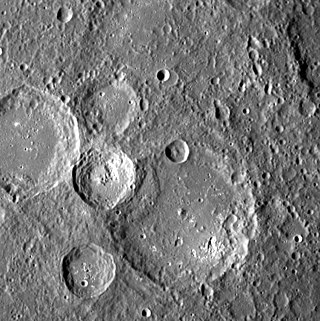
Lermontov is an impact crater on the planet Mercury. The crater is named after Mikhail Yuryevich Lermontov, a 19th-century Russian poet. The name was approved by the International Astronomical Union in 1976.

Raphael is a crater on Mercury. Its name was adopted by the International Astronomical Union (IAU) in 1976, and is named for the Italian painter Raphael. It is Tolstojan in age.

Praxiteles is a crater on Mercury. It is one of 110 peak ring basins on Mercury.

Navoi is a crater on Mercury. It contains uncommon reddish material that indicates a different rock composition from its surroundings. Navoi also appears to have an irregularly shaped depression in its center. Such depressions have been seen elsewhere on Mercury, including within Praxiteles crater, and may indicate past volcanic activity.

Raditladi is a large impact crater on Mercury with a diameter of 263 km. Inside its peak ring there is a system of concentric extensional troughs (graben), which are rare surface features on Mercury. The floor of Raditladi is partially covered by relatively light smooth plains, which are thought to be a product of the effusive volcanism. The troughs may also have resulted from volcanic processes under the floor of Raditladi. The basin is relatively young, probably younger than one billion years, with only a few small impact craters on its floor and with well-preserved basin walls and peak-ring structure. It is one of 110 peak ring basins on Mercury.

Gibran is a crater on Mercury and is in the east of the Shakespeare quadrangle. It was named after Lebanese-American poet Khalil Gibran in 2009. Gibran is located east of the rayed crater of Degas and nearby Damer.

Beckett is a pit-floored crater on Mercury, which was discovered in January 2008 during the first flyby of the planet by the MESSENGER spacecraft. The crater was named in November 2008 by the IAU.

Glinka is a pit-floored crater on Mercury, which was discovered in 1974 by Mariner 10 spacecraft. It was named by the IAU in 2008, after Russian composer Mikhail Glinka.

Scarlatti is a pit-floored crater on Mercury, which was discovered in 1974 by the Mariner 10 spacecraft. It has a prominent peak ring, and it is one of 110 peak ring basins on Mercury. The crater floor is covered by the smooth plains material. The crater displays an arcuate collapse feature along the northeastern peak ring. The size of the pit, which was first noticed in MESSENGER images obtained in January 2008, is 38 × 12 km. Such a feature may have resulted from collapse of a magma chamber underlying the central peak ring complex of the crater. The collapse feature is an analog of Earth's volcanic calderas. Scarlatti is thought to have the same age as the Caloris basin.

To Ngoc Van is a pit-floored crater on Mercury, named after the Vietnamese artist Tô Ngọc Vân. It was discovered in January 2008 during the first flyby of the planet by MESSENGER spacecraft. Its floor displays an irregularly shaped collapse feature, which is called a central pit. The size of the pit is 21 × 10 km. Such a feature may have resulted from collapse of a magma chamber underlying the central part of the crater. The collapse feature is an analog of Earth's volcanic calderas.

Geddes is a crater on Mercury. It has a diameter of 84 kilometers. Its name was adopted by the International Astronomical Union (IAU) in 2010. Geddes is named for the Irish stained glass artist Wilhelmina Geddes, who lived from 1887 to 1955.

Hauptmann is a crater on Mercury. It has a diameter of 118 kilometers. Its name was adopted by the International Astronomical Union (IAU) in 1985. Hauptmann is named for the German playwright Gerhart Hauptmann, who lived from 1862 to 1946.

Mistral is a crater on Mercury. Its name was adopted by the International Astronomical Union (IAU) in 1976. Mistral is named for the Chilean poet Gabriela Mistral, who lived from 1889 to 1957.

Mussorgskij is a crater on Mercury. Its name was adopted by the International Astronomical Union (IAU) in 1979. Mussorgskij is named for the Russian composer Modest Mussorgsky, who lived from 1839 to 1881. The crater was first imaged by Mariner 10 in 1974.

Carolan is a crater on Mercury. Its name was suggested by an Irishman, Fergal Donnelly, and two Americans, Joseph Brusseau and Deane Morrison, in a naming contest which was eventually adopted by the International Astronomical Union (IAU) on 2015. Carolan is named for the Irish composer and performer Turlough O'Carolan, who lived from 1670 to 1738 C.E. The craters Kulthum, Enheduanna, Karsh, and Rivera were also named as part of the contest.

Rivera is a crater on Mercury. It has a diameter of 40 kilometers. Its name was suggested by Mexican residents Ricardo Martinez and Arturo Gutierrez, and American residents Rebecca Hare and José Martinez, in a naming contest which was eventually adopted by the International Astronomical Union (IAU) on 2015. Rivera is named for the Mexican poet Diego Rivera. The craters Carolan, Enheduanna, Karsh, and Kulthum were also named as part of the contest.

Namatjira is a crater on Mercury. It has a diameter of 34 kilometers. Its name was adopted by the International Astronomical Union (IAU) on September 25, 2015. Namatjira is named for the Australian aboriginal artist Albert Namatjira.

Grainger is a crater on Mercury. Its name was adopted by the International Astronomical Union (IAU) in 2012, after the Australian-born composer George Percy Aldridge Grainger.

Donelaitis is a crater on Mercury. Its name was adopted by the International Astronomical Union (IAU) on May 15, 2013. Donelaitis is named for the Lithuanian poet Kristijonas Donelaitis.

Veronese is a crater on Mercury. It has a diameter of 45 kilometres. Its name was adopted by the International Astronomical Union (IAU) on June 28, 2021. Veronese is named for the Italian painter Paolo Veronese.























